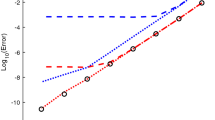Abstract
Runge–Kutta embedded pairs of high algebraic order are frequently utilized when strict tolerances are required. When creating such pairings of orders nine and eight for use in double precision arithmetic, numerous conditions are often satisfied. First and foremost, we strive to keep the coefficients’ magnitudes small to prevent accuracy loss. We may, however, allow greater coefficients when working with quadruple precision. Then, we may build pairs of orders 9 and 8 with significantly smaller truncation errors. In this paper, a novel pair is generated that, as predicted, outperforms state-of-the-art pairs of the same orders in a collection of important problems.





Similar content being viewed by others
Data availability
The coefficients of the new Runge–Kutta pair can be retrieved from http://users.uoa.gr/~tsitourasc/t98.m
Code Availability
The Mathematica package reported in section 2 can be retrieved from http://users.uoa.gr/~tsitourasc/t98.m
An alternative Mathematica module can be found in http://users.uoa.gr/~tsitourasc/rk98.m
References
Butcher, J.C.: Implicit Runge-Kutta processes. Math. Comput. 18, 50–64 (1964)
Butcher, J.C.: On Runge-Kutta processes of high order. In: J. Austral. Math. Soc. 4179–194 (1964)
Butcher, J.C.: Numerical methods for ordinary differential equations. Wiley, 3rd ed., Chichester, 2016
Cassity, C.R.: The complete solution of the fifth order Runge-Kutta equations. SIAM J. Numer. Anal. 6, 432–436 (1969)
Famelis, I.T., Papakostas, S.N., Tsitouras, Ch.: Symbolic derivation of Runge-Kutta order conditions. J. Symbolic Comput. 37, 311–327 (2004)
Fehlberg, E.: Classical fifth, sixth, seventh, and eighth order Runge-Kutta formulas with stepsize control, TRR-287, NASA, (1968)
Hairer, E., Nørsett, S.P., Wanner, G.: Solving ordinary differential equations I: nonstiff problems. Springer, Berlin (1993)
Lefever, R., Nicolis, G.: Chemical Instabilities and sustained oscillations. J. Theor. Biol. 30, 2670–284 (1971)
MATLAB version R2019b, The Mathworks, Inc., Natick, MA
NDSolve: Mathematica function, details in https://reference.wolfram.com/language/ref/NDSolve.html?q=NDSolve
“ExplicitRungeKutta” for NDSolve, https://reference.wolfram.com/language/tutorial/NDSolveExplicitRungeKutta.html
ode89, Matlab function, https://www.mathworks.com/help/matlab/ref/ode89.html?s_tid=doc_ta
Curiosity of low-order explicit Runge-Kutta methods: Oliver, J.A. Math. Comput. 29, 1032–1036 (1975)
Papakostas, S.N., Tsitouras, Ch., Papageorgiou, G.A.: General family of explicit Runge-Kutta pairs of orders 6(5). SIAM J. Numer. Anal. 33, 917–936 (1996)
Sofroniou, M., Knapp, R.: Advanced numerical differential equation solving in Mathematica. In: Wolfram Mathematica Tutorial Collection. Wolfram Research, Champaign (2008)
Storn, R., Price, K.: Differential evolution - a simple and efficient heuristic for global optimization over continuous spaces. J. Glob. Optim. 11, 341–359 (1997)
Storn, R., Price, K., Neumaier, A., Zandt, J.V.: DeMat, Available online: https://github.com/mikeagn/DeMatDEnrand (accessed on 25 March 2022)
Tsitouras, Ch.: A tenth order symplectic Runge-Kutta and Nyström method. Cele. Mech. Dynam. Astron. 74, 223–230 (1999)
Tsitouras, Ch.: Optimized explicit Runge-Kutta pairs of orders 9(8). Appl. Numer. Math. 38, 123–134 (2001)
Tsitouras, Ch.: Explicit Runge-Kutta methods for starting integration of Lane-Emden problem. Appl. Math. Comput. 354, 353–364 (2019)
Tsitouras, Ch., Papageorgiou, G.: Runge-Kutta interpolants based on values from two successive integration steps. Computing 43, 255–266 (1990)
Tsitouras, Ch., Papakostas, S.N.: Cheap error estimation for Runge-Kutta methods. SIAM J. Sci. Comput. 20, 2067–2088 (1999)
Tsitouras, Ch., Simos, T.E.: High algebraic, high phase-lag order embedded Numerov-type methods for oscillatory problems. Appl. Math. & Comput. 131, 201–211 (2002)
Verner, J.H.: Explicit Runge-Kutta methods with estimates of the local truncation error. SIAM J. Numer. Anal. 15, 772–790 (1978)
Verner, J.H.: A contrast of some Runge-Kutta formula pairs. SIAM J. Numer. Anal. 27, 1332–1344 (1990)
Verner, J.H.: Some Runge-Kutta formula pairs. SIAM J. Numer. Anal. 28, 496–511 (1991)
Verner, J.H.: Numerically optimal Runge-Kutta pairs with interpolants. Numer. Algor. 53, 383–396 (2010)
Verner, J.H.: https://www.sfu.ca/~jverner/RKV98.IIa.Robust.000000351.081209.FLOAT6040OnWeb
Wolfram Research, Inc., Mathematica, Version 11.3.0, Champaign, IL (2018)
Funding
The research was supported by a Mega Grant from the Government of the Russian Federation within the framework of the federal project No. 075-15-2021-584.
Author information
Authors and Affiliations
Contributions
All the authors contributed equally.
Corresponding author
Ethics declarations
Ethical approval
Not applicable.
Conflict of interest
The authors declare no competing interests.
Additional information
Publisher's Note
Springer Nature remains neutral with regard to jurisdictional claims in published maps and institutional affiliations.
Rights and permissions
Springer Nature or its licensor (e.g. a society or other partner) holds exclusive rights to this article under a publishing agreement with the author(s) or other rightsholder(s); author self-archiving of the accepted manuscript version of this article is solely governed by the terms of such publishing agreement and applicable law.
About this article
Cite this article
Kovalnogov, V.N., Fedorov, R.V., Karpukhina, T.V. et al. Runge–Kutta pairs of orders 9(8) for use in quadruple precision computations. Numer Algor 95, 1905–1919 (2024). https://doi.org/10.1007/s11075-023-01632-8
Received:
Accepted:
Published:
Issue Date:
DOI: https://doi.org/10.1007/s11075-023-01632-8




